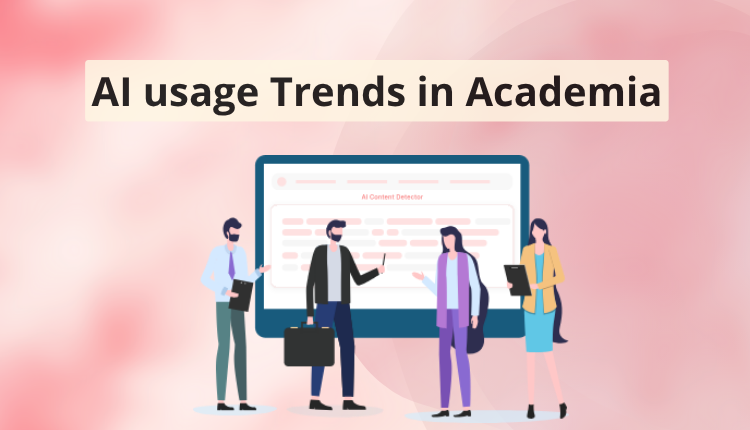AI usage Trends in Academia

Imagine walking onto the stage at your graduation—a moment meant to honor years of hard work—and instead of being greeted by a proud faculty member, you hear a synthetic AI voice announce your name as you scan a QR code. This scenario occurred at Pace University, where AI voices replaced human announcers in a bid to achieve perfect pronunciation. While the intention was to enhance accuracy, it ended up feeling distant and impersonal, likened by one graduate to a “supermarket self-checkout.”
At UCLA in June 2025, another graduate, Andre Mai, made headlines by openly displaying his laptop screen showing ChatGPT as he crossed the stage. His move was a cultural statement—acknowledging AI’s role in his success. By doing so, Mai sparked a conversation about the blurred boundaries between assistance and plagiarism, as well as authenticity versus augmentation. This reflected how students increasingly view AI as a partner rather than just a tool.
The Surge in AI Adoption in Academia
AI has become a crucial part of academia, influencing teaching, learning, administration, and research. The global AI in education market is expected to reach $25 billion by 2027, with North America and Asia-Pacific leading the way. However, the pace of policy development hasn’t kept up with the rapid adoption of AI. For instance, only about 39% of institutions have updated or created new AI policies, despite a strong interest from faculty and leadership.
Currently, AI policies in academia are fragmented, with universities taking diverse stances. The 2025 Educause survey revealed that some schools have banned AI tools in coursework, while others, like Ohio State University, have made AI fluency mandatory for incoming students. Despite these efforts, many students feel they lack understanding of their institution’s AI policies, signaling a communication gap.
AI’s growth in academia is not just anecdotal—it’s backed by numbers. According to a 2024 survey by the Digital Education Council, 86% of students worldwide use AI tools in their coursework, with 24% using them daily and 54% weekly or more. The most common uses are for searching information (69%), grammar checking (42%), summarizing documents (33%), paraphrasing (28%), and drafting initial content (24%). ChatGPT leads in usage (66%), followed by Grammarly and Microsoft Copilot (25% each). In 2025, 92% of students report using AI in some form, and 88% have used generative AI for assessments.
AI’s impact on higher education is significant—83% of academic leaders believe generative AI will change education, and 65% think its benefits outweigh the risks. The focus is shifting toward responsible AI usage, ethical concerns, privacy issues, and preparing students and faculty for an AI-enhanced academic world. While 86% of education organizations globally report using AI, only 36% of students have received institutional support to develop AI skills. A global student survey by DEC showed that 58% of students feel they lack adequate AI knowledge and 48% feel unprepared for an AI-driven workforce, highlighting the need for structured AI education and guidance within academic institutions.
Institutional Challenges: Balancing Innovation and Integrity
AI detection tools such as Turnitin, GPTZero, and Copyleaks are being widely used in academic settings, but their reliability is still a concern. With high false positive rates, students might be unfairly penalized, while subtler AI applications often go unnoticed. In response, many professors are resorting to traditional methods like oral exams, reviewing multiple drafts, and conducting one-on-one assessments to ensure authenticity. Most educators still lack formal training in AI ethics, detection methods, and teaching strategies. A UK study found that educators identified AI-written work correctly only 7% of the time, showing how unprepared many faculty members are for this evolving challenge. While faculty AI literacy is improving—42% of students now report that faculty are capable of helping with AI (up from 18% in 2024)—gaps remain. Tools like Documark, which analyze writing patterns across drafts, are helping to address this issue.
A Roadmap for Balanced AI Integration:
-
Empower Students and Faculty: Collaborate with students to develop clear, relevant, and transparent AI policies. Expand faculty training on AI detection, pedagogy, and digital ethics to bridge preparedness gaps. Equip faculty with the necessary tools to assess student work and train students in AI usage.
-
Revamp Assessments: Implement a mix of written, oral, collaborative, and in-class assessments to ensure authenticity and minimize reliance on AI-generated outputs.
-
Promote AI Literacy: Integrate AI education into various disciplines, teaching students how AI operates, its limitations, and strategies for verifying AI-generated content. Encourage responsible AI practices and transparent citation.
Adapting to the New Normal
Returning to Andre Mai and his ChatGPT moment, his gesture signaled that AI is now embedded in modern education. Institutions must adapt to the technological fluency and expectations of today’s learners. Are they ready to create an academic environment where AI augments, rather than replaces, human effort?
Forward-thinking universities will treat AI as an essential part of their infrastructure, providing ethical guidance and ensuring inclusive access. Those who don’t risk losing relevance.
As AI continues to shape academic writing, institutions will need clear direction. Tools like Documark offer actionable insights to help educators identify authentic student work, support learning, and uphold academic integrity. Ready to explore how Documark can help your campus navigate this new academic landscape? Book a tailored walkthrough today.




